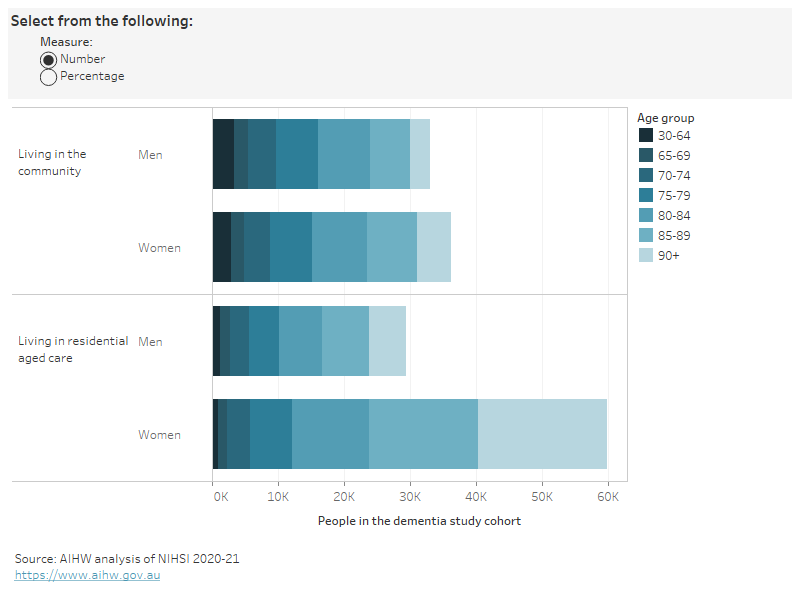Demographics
The dementia study cohort comprises 158,730 people aged 30 and over who were living in Australia in 2019 and had a dementia record in the linked data.
The use of health services changes after a person enters permanent residential aged care. For example, general practitioner attendances increase, and specialist attendances decrease (AIHW 2020, 2022, 2023). To partly account for these changes, the dementia study cohort was split into 2 study groups:
- People living in the community: includes 69,390 people (44% of the cohort) who were living in the community for all of 2019. This may include people who used residential respite care, people who were living in other supported accommodation, and people who were living in residential aged care facilities not included in the linked data (see Box 1.1).
- People living in residential aged care: includes 89,340 people (56% of the cohort) who were living in permanent residential aged care for all or part of 2019.
Differences in the number, age and sex profiles of people living in the community and in residential aged care (see Figure 1.1) should be borne in mind when exploring the results in this report, and direct comparisons are not recommended.
- There were a similar number of men and women living with dementia in the community, however, the number of women living in residential aged care was double that of men (partly because women have a longer life expectancy than men, so are more likely to need care at older ages)
- People living in residential aged care were older (55% were aged 85 and over) than those living in the community (32% were aged 85 and over).
- Women were more likely than men to be aged 85 and over, both in residential aged care (60% and 43%, respectively) and in the community (35% and 28%, respectively).
To account for some of the differences due to age, age-standardised rates are reported where possible.
Figure 1.1: Number and percentage of people in the dementia study cohort, by place of residence, sex and age group, 2019
Figure 1.1 is an interactive bar chart showing the number and percentage of people in the dementia study cohort by age group and sex. There were about 33,100 men and 36,300 women living in the community who had a dementia record in the linked data. The age profile of men and women was similar, although a slightly higher proportion of men were aged 30–64 (9.9% compared with 7.8%), and higher proportion of women were aged 90 or over (14% compared with 9.2%). There were twice as many women (59,900) as men (29,400) living with dementia in residential aged care. One third (33%) of women were aged 90 or over, compared with 19% of men.

Notes
1. The dementia study cohort refers to 158,730 people aged 30 and over who were living in Australia in 2019 and had a dementia record in the NIHSI. Western Australia and the Northern Territory were excluded from all analyses because their hospital data were not available for construction of the cohort.
2. A small number of SA2s with no SEIFA IRSD ranking were excluded from age group analysis because they could not be assigned to a Remoteness Area/IRSD group. As a result, totals for the cohort, remoteness and socioeconomic areas do not sum to the totals for States/territories and SA4 regions.
Data tables: Number and percentage of people in the dementia study cohort
Australian Institute of Health and Welfare (AIHW) (2020) Australia’s health 2020: data insights – Chapter 7: Changes in people’s health service use around the time of entering permanent residential aged care, AIHW, Australian Government, accessed 27 June 2023. doi:10.25816/5f05371c539f3.
AIHW (2022) Younger onset dementia: new insights using linked data, AIHW, Australian Government, accessed 22 February 2023. doi:10.25816/cc5a-tm25
AIHW (2023) Dementia in Australia, AIHW, Australian Government, accessed 28 June 2023.


